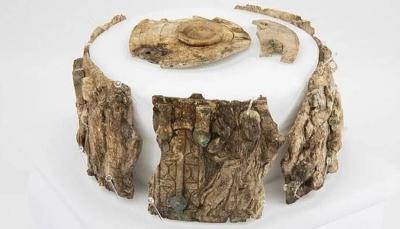The Ten Commandments may be the first revelation that organizes people's lives on this earth, delivered to the Prophet Moses at Mount Sinai after he spoke with the Creator. This is the religious narrative of the matter, supported by texts from the Old Testament. However, the British "Daily Mail" reports on a round ivory box found by archaeologists inside a marble tomb in a church carved into rock in southern Austria, featuring engravings depicting "the Word of God" Moses receiving the commandments. This ivory box is 1,500 years old, and its engravings show saints and the ascension of Jesus Christ to heaven. This box is considered an important discovery as sacred finds regarding the beginnings of Christianity are very rare.
The engravings depict figures with beards, dressed in long garments, in scenes from both the Old and New Testaments. There are theories suggesting that the Prophet Moses and Jesus Christ are depicted among these figures, as researchers believe Moses is portrayed in the first scene receiving the commandments from God, or striking his staff in the water to part the sea for the crossing to Palestine. The second scene represents the resurrection of Jesus Christ after his crucifixion. According to the "Daily Mail," a figure can be seen being pulled by a hand emerging from the clouds, "this is the hand of God in the scene of the ascension," the report states. The scene also includes horses and a chariot.
Several passages in the Bible, specifically in the Book of Revelation (19:11), mention a horse: "Then I saw heaven opened, and behold, a white horse; and he who sat on it is called Faithful and True, and in righteousness, he judges and makes war." The Book of Exodus also speaks of the Egyptians riding horses and chariots while pursuing Moses and the Israelites. The research team also raises the possibility that these engravings depict the ascension of the prophet Elijah to heaven, as mentioned in the Book of Kings: "And as they still went on and talked, behold, chariots of fire and horses of fire separated the two of them. And Elijah went up by a whirlwind into heaven."
Archaeologists believe this artifact was created after the Roman Emperor Constantine the Great believed in Christ and Christianity, issuing the Edict of Milan in 313 AD, legalizing this religion and promoting religious tolerance. They also exclude the possibility that it was made in southern Austria, where it was found, "as the materials used to craft it are not available in that region, and its fine craftsmanship likely indicates it was made in Alexandria, Ravenna, or Aquileia," according to the "Daily Mail." Notably, the box was found broken, suggesting it had been damaged before being placed in the large marble tomb.




